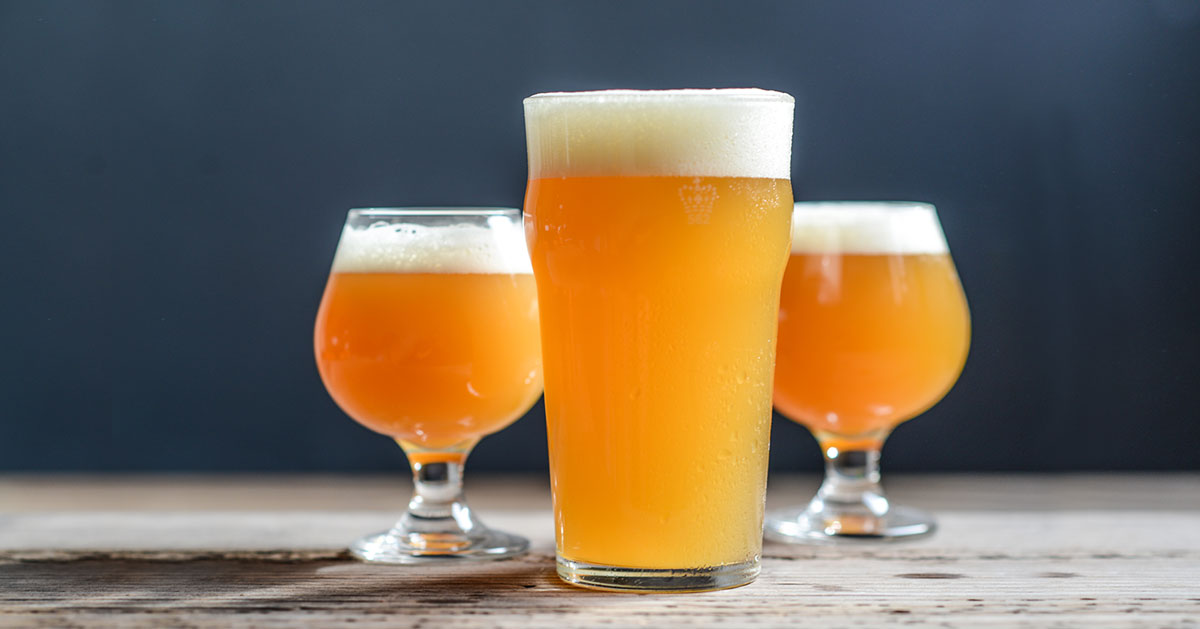Easiest Beer Recipe
The best beer recipes are available in a beer-making kit. Why? Because these kits make the home brewing process easier. When you save time gathering the essential ingredients and equipment, you can invest more time and energy into brewing the best damn beer possible. In this article, we take a closer look at the best beer recipes for beginners and how beer-making kits can be helpful for home brewers at all levels.
What Is the Easiest Beer To Make at Home?
The best homemade beer recipe for beginners is one with straightforward steps and a forgiving flavor profile. Generally, these easy beer types are ideal for beginners:
At Great Fermentations, we tend to recommend the Chico Suave Pale Ale Beer Kit for new brewers. Of course, you should go with the recipe you think you’ll enjoy tasting the most!
Are IPA Beers Easier To Make?
IPAs are one of the more straightforward beers to make at home. That means they tend to follow the basic home brewing steps we cover in the next section. Other brews, like sours, add entirely new steps! IPAs are also widely available in beer ingredient kits, which can help make the process smoother.
IPAs do come with some challenges, however. As a lighter beer, the flavor profiles are more finicky than in darker beers. This means that errors in the brewing process will have a larger impact on the final product.
For new brewers, a pale ale could be a better choice than an IPA. While the two types of beer are fairly similar, the flavors in pale ales are easier to balance.
What Are the 4 Steps of Beer Making?
The 4 main steps in a simple beer recipe are:
- Brew the wort.
- Ferment the wort into beer.
- Bottle the beer.
- Store beer, then enjoy!
Let’s take a closer look at the details of each of these steps.
- Brew the Wort
Gather equipment and supplies. On your brewing day, you’ll need:
Heat source
Brew pot
Fermenter
Hops
Grains
Yeast
Thermometer
Airlock
Stirring spoon
Cleaning and sanitizing supplies
Hydrometer
Measuring cup
Some of these items will be ready to go in your kitchen. You can quickly get the rest with either a beer ingredient kit or a homebrew starter kit for equipment.
Clean equipment. Ensure everything that will touch your beer is squeaky clean. By removing any and all gunk and residue, you can make your sanitizing process much more effective.
Sanitize equipment. Before each and every use, thoroughly sanitize your equipment to keep pesky contaminants from messing with your batch’s taste and presentation. This is a crucial step to get right, so make sure you’re using cleaning and sanitizing supplies that are specifically designed for brewing beer.
Brew wort. Start by steeping your grains in water. Then, combine your grains with the malt extract. As you bring the mixture to a boil, stir in the hops and any extra flavors.
- Ferment the Wort into Beer
Chill wort. Transfer the wort to the fermenter. Cool the wort with ice or cold water. For best results, use a home brew chiller. Typically, aim for between 75ºF and 80ºF.
Add yeast. Now that your wort is cooled down, the yeast will be able to do its job better. Add yeast into the wort, then seal it tight with an airlock.
Let the wort ferment into beer. This usually takes about 2 weeks, but the exact fermentation time varies between recipes. Some recipes even suggest a second fermentation process!
- Bottle the Beer
Gather equipment and supplies. For the bottling day, you’ll need:
Cleaning and sanitizing supplies
Bottling container with spigot
Priming sugar
Siphon
Capper
Bottles and caps
Clean equipment. Once again, you’ll want to make sure that all of your equipment is free from gunk, residue, dust, and anything else that could get in the way of your sanitizing solution.
Sanitize equipment. It’s important to sanitize your equipment shortly before each use. This will minimize the risk of annoying contaminants that could have a negative impact on your beer’s flavor, aroma, and color.
Prep the bottling container with priming sugar. Adding priming sugar to the bottling container before transferring in the beer will help your beer begin carbonating properly.
Transfer the beer to the bottling container. You could attempt to dump the beer from your fermenter into your bottling container, but lifting 5 gallons of liquid is no joke. You’ll also risk spilling precious beer. Instead, we recommend using a siphon to transfer your beer into the bottling container easily.
Fill bottles. Connect the spigot on your bottling container to your bottles with tubing to reduce spillage. There’s always a risk of making a mess, however, so make sure you have paper towels and other cleaning supplies on hand.
Cap and seal each bottle. An airtight seal is critical for protecting your beer against contamination, so use your capper to ensure a proper seal.
- Store Beer, then Enjoy!
Store bottles. Find a dark space to store your filled and sealed bottles for about 2 weeks at room temperature. This will allow the carbonation process to finish before you pop any tops.
Enjoy your homemade beer with friends and family! You put in weeks of effort—now it’s time to kick back and relax with friends and family while enjoying your home-brewed beer!
Certain beer recipes will vary from these general steps, so be sure to follow your recipe’s specific instructions!
What Is the Simplest Way To Make Beer at Home?
The simplest way to make beer at home is by starting with a beer-making kit. Why are these kits the solution for how to make beer at home easy? Because they provide 3 key advantages:
- You save time by buying your essentials in assorted kits. Rather than going from store to store, you can get what you need all in one place.
- You save money by paying for only what you need. Whether you’re buying equipment or ingredients, it stinks to pay for items you’ll never use. Beer-making kits are tailored to only include what you’ll actually use—no more, no less.
- You save yourself from frustration by using kits that come with detailed instructions. When you brew it right the first time, you save time, money, and you get to actually enjoy what you worked so hard to make.
Can You Make Beer Without a Kit?
You can make beer without a kit, but it will be more challenging than using one. That means you would risk spending more time and money to wind up having a bad time with only subpar beer to show for your efforts.
But what if you’ve been brewing at home for a while and are looking to take the next step in this hobby?
You can always try beer ingredient kits for more challenging brews, like light lagers. This will allow you to flex your home brewing skills without wasting time at the store.
Are Beer-Making Kits Worth It?
Beer-making kits are worth it for home brewers who value their time, money, and energy. But what about quality? Can you find the best homemade beer recipe in a kit? You sure can! There is a wide variety of beer ingredient kits to match an equally wide range of tastes. You can also find free beer recipes floating around online. However, you have to be careful with these, as they often have not been vetted and tested thoroughly.
Can You Make Beer Cheaper Than Buying It?
Over the long run, many home brewers can make their own beer for less money than they could buy it from a grocery store, restaurant, or bar. In fact, the price per bottle can get quite low after you’ve invested in home brewing equipment. You can calculate your savings using the following formula:
- Savings = (Cost of buying beer) – (Cost of ingredients) – (Cost of one-use supplies) – (Allocated cost of reusable supplies) – (Allocated cost of equipment)
What Are the Key Ingredients in Making Beer?
The key ingredients in beer are:
- Water: Water forms the base of your brew.
- Yeast: Yeast turns sugar into alcohol during the fermentation process.
- Hops: These ingredients provide bitter flavors for your brew.
- Malted Grains: These ingredients provide sweet flavors for your brew.
Additional ingredients that can also help your brews are extra flavors to fine-tune your beer’s taste and priming sugar, which helps with the carbonation process.
Can You Make Beer with Just Yeast?
Yeast can’t make beer by itself. It needs sugar to interact with in order to produce alcohol. Typically, this sugar is provided with malted grains, which also contribute a lot of the flavor that’s associated with beer. Hops are also helpful in balancing out the sweetness from grain with bitterness. In fact, without hops, you’d be brewing an entirely different type of alcoholic beverage known as gruit!
Dive into Home Brewing with Great Fermentations!
The entry point into home brewing is different for everyone. No matter what your starting point it, Great Fermentations has what you need to dive in—or dive deeper. Explore our wide selection of beer ingredient kits and homebrew starter kits that equip you with exciting recipes and long-lasting equipment.



